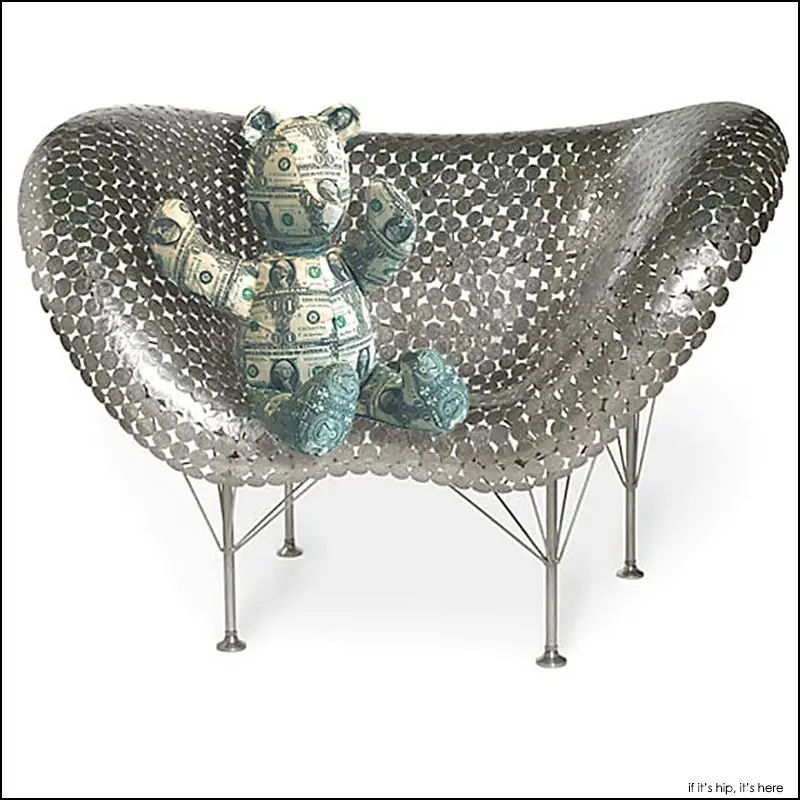A trained sculptor and licensed welder, 49 year old Vermont-based artist Johnny Swing, an alumnus of Skidmore College and Skowhegan School of Painting and Sculpture uses found materials and objects to repurpose into art, furniture and more.
Johnny Swing Coin Furniture

With a vast amount of work to his credit, it’s his American coin-soldered furniture and paper currency printed objects I want to share with you today. Below are several angles, images and information pertaining to his soldered coin furniture followed by some of his textile objects made with dollar printed fabrics.
The Nickel Couch, 2006:
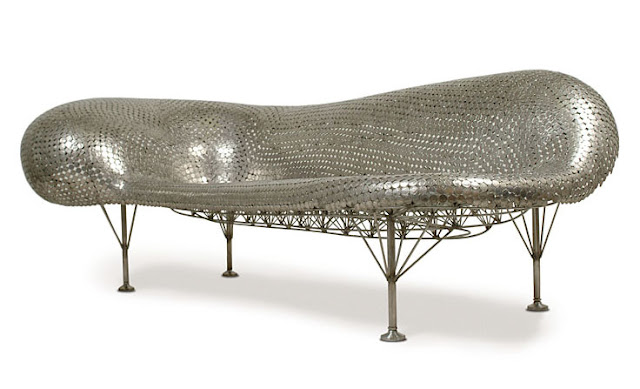
His second in his series of furniture made from coins, the nickel couch is comprised of 7,000 nickles, 35,000 welds, and a substructure of stainless truss work utilizing 350 feet of stiffening rods. 80″wide x 42″deep x 28.5″ high and weighs 125 pounds.

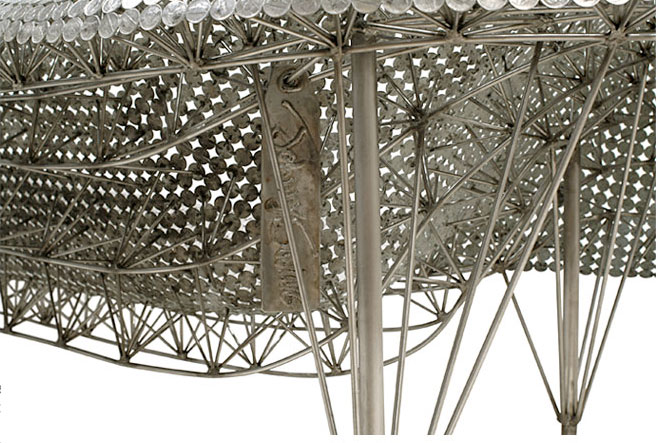

above: Swing’s Nickel Couch, 2001, fetched over $100,000 at auction at Sotheby’s in December of 2009.
Quarter Lounge, 2008:

Quarters and stainless steel, 96 x 47 x 28 inches


Half Dollar Butterfly Chair, 2009:

The third in his series of coin furniture, the Butterfly chair, reveals an exposed substructure and is made of 1,500 half dollar coins and 7,000 welds. 46″wide x 32″deep x 34″ high and weighs 58 lbs.
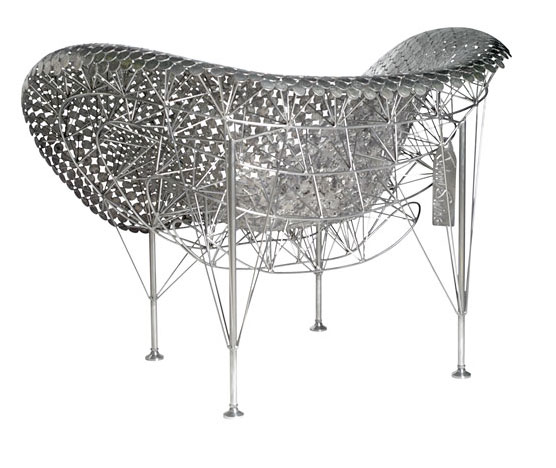

The Quarter Chair:
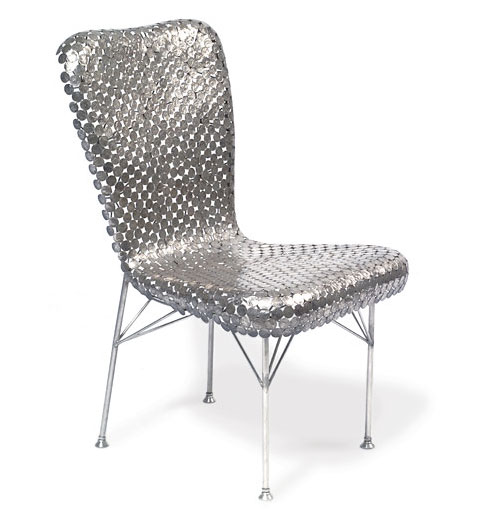
The fourth in his series of coin pieces, the Quarter chair has an hourglass shape and is made from approximately 1,200 quarters. The shape and proportion are that of traditional dining room furniture. 21″ wide x 24″ deep x 36″ high and weighs 28 lbs.



The Loose Change Chair:

The fifth in the series of coin furniture, this was inspired by the childhood game Booby Trap. The substructure is created from technology shared from airplane wing design; it flexes to the ground but is torsionally rigid to accommodate thousands of pounds.


The Quarter Stool:

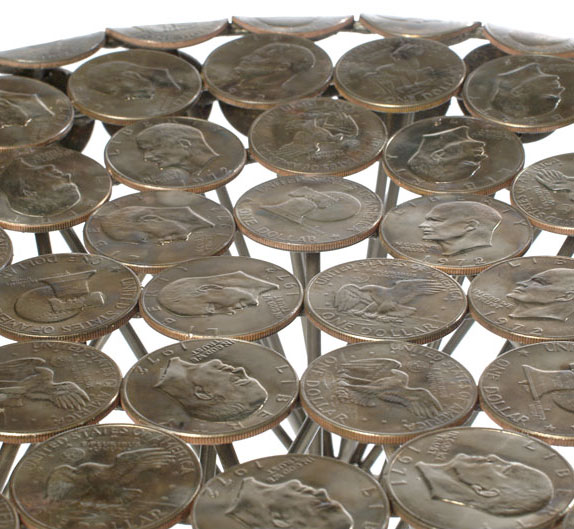
Nickel Bowl:
His bowls are an effort to play with other shapes that force the constrained circular coin into complex forms and patterns similar to mosque screens and Native American woven baskets.


All The Kings Men, 2010:

One of his most recent pieces, All the Kings Men is a curved settee with soldered open framework underside made of half dollars and stainless steel and measures 97″ x 52″ x 28″ inches.

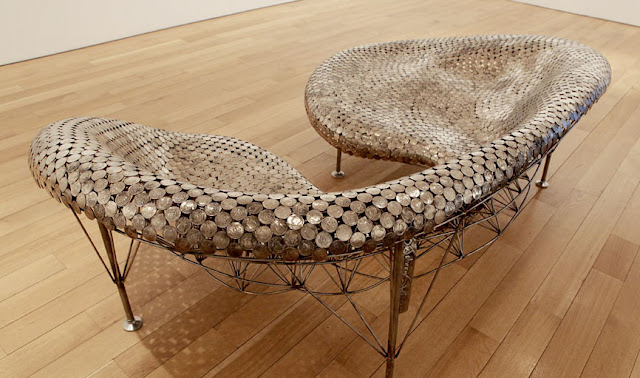


As Kiera Scholten reported for Artworks Magazine about his Coin series in 2008:
When he began using coins, Swing says it wasn’t simply about money as a material-”it was about taking what was a useless piece of money and kind of making it special again.” With this idea in mind he constructed his first piece out of pennies. What many consider America’s most disposable piece of coinage suited his purpose perfectly. Swing was happy with his first piece, which he modeled after a Bertoli chair, but using the pennies became a problem. After 1981 pennies were made with zinc, which caused them to disintegrate when welded together. Finding thousands of pennies dating before Reagan took office made an already labor-intensive process even more of a chore.
So he moved on to nickels. He’s now created 20 nickel couches, each assembled using about 7,000 of the Jefferson coins-that’s $350. His half-dollar chair utilizes about 1,500 coins, or $750. The price of these pieces, though, is much more than face value. You would have to save a lot of five-cent pieces to afford the couch made of them. An original Johnny Swing Nickel Couch can be had for upwards of $50,000. But the price pays for a painstaking process; for one couch it takes more than 300 hours to complete the 35,000 welds that hold all the coins together.
Welding coins together simply to sit on them may seem like a strange concept, and some critics are quick to classify Swing’s work as “bad boy art” under the assumption that he’s defacing money by using it in this manner. At first, even Swing wasn’t sure if his art was illegal, though his original answer was that “the government doesn’t care if you use their objects in art; they’re sort of flattered.” He soon thought he had better check it out to be certain, so he called the Secret Service, which at the time was a part of the U.S. Treasury. “They said, ‘It’s your money, do with it what you want,’” says Swing. “The agent told me the rumor that destroying money is illegal is just an old wives’ tale to keep kids from putting coins on the railroad tracks.” Swing could breathe a sigh of relief and move ahead with his work.
In addition to using coins, he has also created the following pieces using fabric printed with US Currency.
Piggy:


Teddy Bear:


Throw pillow:


To give you an idea of the cost, the price for the Dollar Teddy is $1,250.00 and the Butterfly Coin chair is $59,000.00
See more of his work here
all images courtesy of the artist
